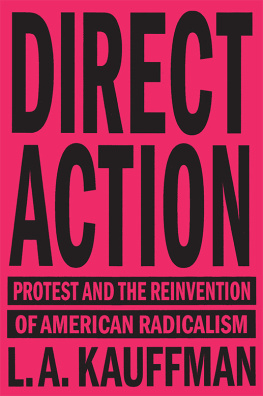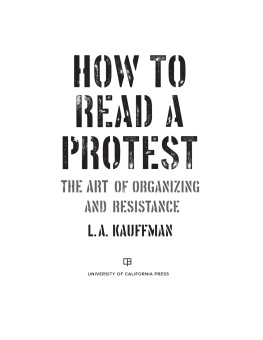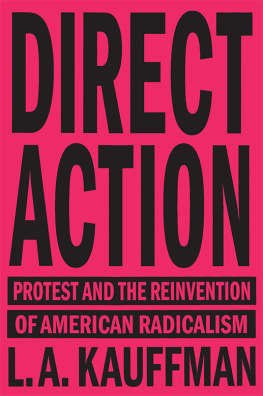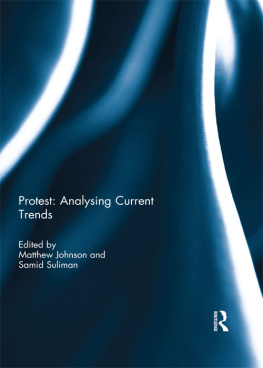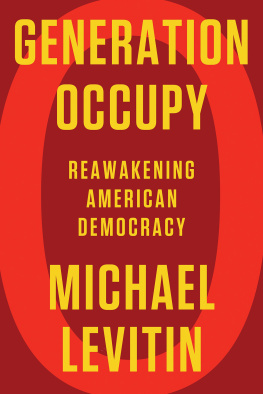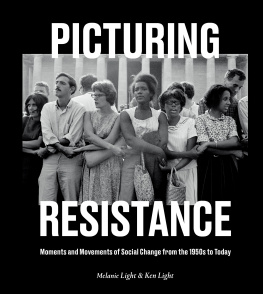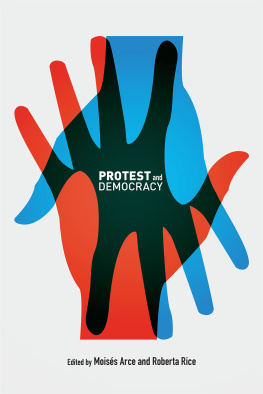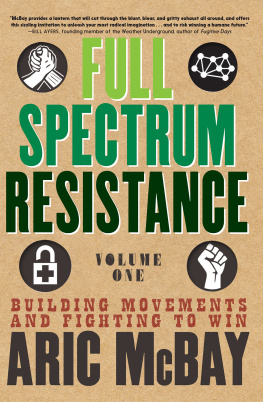DIRECT
ACTION
Protest and the Reinvention
of American Radicalism
L.A. Kauffman

First published by Verso 2017
L.A. Kauffman 2017
All rights reserved
The moral rights of the authors have been asserted
1 3 5 7 9 10 8 6 4 2
Verso
UK: 6 Meard Street, London W1F 0EG
US: 20 Jay Street, Suite 1010, Brooklyn, NY 11201
versobooks.com
Verso is the imprint of New Left Books
ISBN-13: 978-1-78478-409-6
ISBN-13: 978-1-78478-422-9 (UK EBK)
ISBN-13: 978-1-78478-410-2 (US EBK)
British Library Cataloguing in Publication Data
A catalogue record for this book is available from the British Library
Library of Congress Cataloging-in-Publication Data
A catalog record for this book is available from the Library of Congress
Typeset in Garamond by MJ&N Gavan, Truro, Cornwall
Printed in the US by Maple Press
To the memories of
Armando Perez (19481999)
Ray Davis (19631999)
Franoise Cachelin (19232003)
Brad Will (19702006)
Contents
What happened to the American left after the sixties? Whole bookshelves groan under the weight of histories of the sixties, and both the Old Left and the New Left have been richly and extensively studied. Yet, while significant waves of activism have punctuated the history of the last forty years, the story of American radicalism in recent decades remains almost untold.
That may be, at least in part, because the story is such a difficult one to tellnot for lack of radical endeavors over this time period, but because of their profusion. Its not simply that theres no single organization or political tendency or leader that could plausibly represent the larger left. The most significant dynamic in American radicalism in the period after the sixties has been a proliferation of movements, causes, and political identities. These are so numerous that listing them all would be tedious: the landscape of the contemporary left includes feminisms of many forms and hues; radical movements for racial justice as varied as the communities of color that have given rise to them; lesbian, gay, bisexual, transgender, and queer radicalisms, evolving and complex; radical forms of environmentalism, from deep ecology to the climate justice movement; labor-based radicalisms and multiple strains of anarchism and socialism. At times, it can seem like the number of recent radicalisms stands in inverse proportion to their overall influence, for on the whole, the period since the 1960s has been inhospitable for the left. In the face of this tangled multiplicity of movements and political initiatives, its perhaps not surprising that there have been few attempts to survey the post-sixties radical landscape as a whole, to tease out broad historical patterns from the plethora of organizations, mobilizations, and events.
This book represents one telling of the tale, a distillation of more than thirty years of observation, reporting, and organizing on the frontlines of many of these movements. The story of American radicalism is told here through the lens of direct action: the fierce, showy tradition of disruptive protest employed by many of the eras most distinctive and influential movements. Direct action was far from the only approach used by radical movements throughout this era, and theres no claim here that its always the best or most productive one. It has, though, consistently served as a laboratory for political experimentation and innovation, and as an arena for grappling with many of the big challenges facing progressive movements more generally: how to win meaningful victories and sustain communities of resistance in a rightward-shifting political climate; how to build movements that dont replicate the very power dynamics they seek to challenge, especially in matters of race and gender; how to create effective political alliances that respect the voice and autonomy of all partners; how to inspire vision, hope, and action in hard times.
Direct action can refer to a huge variety of efforts to create change outside the established mechanisms of governmentits a slippery and imprecise term, much debated by the movements that use it. Protest marches, boycotts, and strikes all are, or can be, forms of direct action; the same is true of picket lines, sit-ins, and human blockades. The term itself dates back about a century, having first been widely used by the early twentieth-century Industrial Workers of the World (IWW), known colloquially as the Wobblies, the liveliest and most fiercely anti-capitalist labor movement in US history. The working class and the employing class have nothing in common, the IWWs manifesto began, and the organization always considered the complete abolition of capitalism to be its ultimate goal. Toward that end the Wobblies called for industrial action directly by, for, and of the workers themselves, without the treacherous aid of labor misleaders or scheming politicians, action that encompassed everything from work slowdowns and factory occupations to industrial sabotage.
It is the black civil rights movement of the 1950s and the 1960s that serves as the most important touchstone for the direct-action movements of recent decades, however. From the Montgomery bus boycott and the Greensboro lunch counter sit-ins to the Freedom Rides and the march over Selmas Edmund Pettus Bridge, the civil rights movements acts of resistance to racial segregation and white supremacy have become so emblematic of transformative collective action that every major movement since has referenced them in some way. The mythic status acquired by the civil rights movement over time cemented its role as model and inspiration, even as persistent racial divisions on the left complicated claims to its legacy. But the basic vision of direct action outlined by Dr. Martin Luther King Jr. in his letter from Birmingham jail has shaped its use ever since: Nonviolent direct action seeks to create such a crisis and foster such a tension, King famously wrote, that a community which has constantly refused to negotiate is forced to confront the issue. It seeks so to dramatize the issue that it can no longer be ignored.
Direct action is most closely associated with movements of the left, but there is no necessary correlation between a movements use of direct action and its politics: disruptive protest can be employed to further all kinds of agendas, some downright reactionary. Most dramatically, the anti-abortion group Operation Rescue organized a massive and sustained campaign of blockades outside abortion clinics in the late 1980s, involving more than 20,000 arrests. The guide that many of these blockaders used, anti-abortion activist Joseph M. Scheidlers 1985 Closed: 99 Ways to Stop Abortion, directly echoed the catalog of protest methods found in political scientist Gene Sharps 1973 classic

